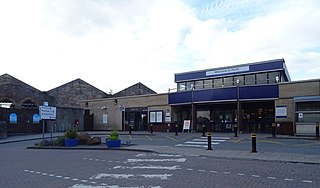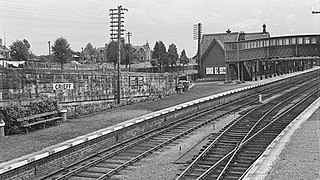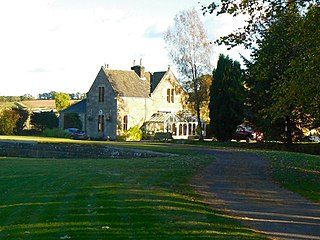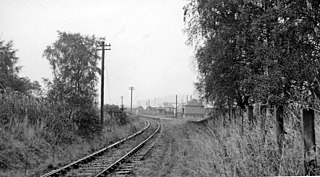
The Caledonian Railway (CR) was a major Scottish railway company. It was formed in the early 19th century with the objective of forming a link between English railways and Glasgow. It progressively extended its network and reached Edinburgh and Aberdeen, with a dense network of branch lines in the area surrounding Glasgow. It was absorbed into the London, Midland and Scottish Railway in 1923. Many of its principal routes are still used, and the original main line between Carlisle and Glasgow is in use as part of the West Coast Main Line railway.

Perth railway station is a railway station located in the city of Perth, Scotland, on the Glasgow to Dundee line, and the Highland Main Line. It is managed by ScotRail, who provide almost all of the services.

Gleneagles railway station serves the town of Auchterarder in Perth and Kinross, Scotland.
The Lochearnhead, St Fillans and Comrie Railway company was formed to build a line along the valley of Strathearn, closing the gap between the Callander and Oban line of the Caledonian Railway and Crieff. Tourism was on the increase in the area, and there were ambitious ideas that imported goods traffic at Oban would be routed to the eastern Scotland towns and cities over the line.
The Crieff Junction Railway was opened in 1856 to link the town of Crieff to the main line railway network in Scotland, at a junction at the present day Gleneagles station. In the second half of the twentieth century railway business declined sharply, and despite economy measures the line closed in 1964.
The Crieff and Methven Junction Railway was a Scottish railway, opened in 1866, connecting Crieff with a branch line that ran from Methven to Perth.

Crieff was a junction railway station at Crieff, Perth and Kinross, Scotland. It was where the Crieff Junction Railway, Crieff & Methven Railway and the Comrie, St Fillans & Lochearnhead Railway met.
Innerpeffray railway station served the hamlets of Innerpeffray and Millhills in the Scottish county of Perth and Kinross.

Abercairney railway station served the Abercairny estates in the Scottish county of Perth and Kinross.

Madderty railway station served the locality of Madderty in Perthshire, Scotland. The village of St. Davids is around one mile to the south.

Balgowan railway station served the village of Balgowan, in the Scottish county of Perth and Kinross.
Methven Junction railway station opened in 1866, following the extension of the already existing Perth, Almond Valley and Methven Railway line which terminated in the village of Methven to the north. This new line, operated by the Crieff and Methven Junction Railway continued westwards from this junction through Balgowan, Madderty, Abercairney, Innerpeffray and finally, Crieff. Following the closure of Methven Station on 27 September 1937, Methven Junction was renamed 'Methven Junction Halt' until its own closure as a passenger station on 1 October 1951.
The Scottish Central Railway was formed in 1845 to link Perth and Stirling to Central Scotland, by building a railway line to join the Edinburgh and Glasgow Railway near Castlecary.

The Aberdeen Railway was a Scottish railway company which built a line from Aberdeen to Forfar and Arbroath, partly by leasing and upgrading an existing railway.
The Scottish Midland Junction Railway was authorised in 1845 to build a line from Perth to Forfar. Other companies obtained authorisation in the same year, and together they formed a route from central Scotland to Aberdeen. The SMJR opened its main line on 4 August 1848. Proposals to merge with other railways were rejected by Parliament at first, but in 1856 the SMJR merged with the Aberdeen Railway to form the Scottish North Eastern Railway. The SNER was itself absorbed into the larger Caledonian Railway in 1866. The original SMJR main line was now a small section of a main line from Carlisle and central Scotland to Aberdeen.
The Scottish North Eastern Railway was a railway company in Scotland operating a main line from Perth to Aberdeen, with branches to Kirriemuir, Brechin and Montrose. It was created when the Aberdeen Railway amalgamated with the Scottish Midland Junction Railway on 29 July 1856. It did not remain independent for long, for it was itself absorbed by the Caledonian Railway on 10 August 1866.
The Crieff and Comrie Railway was a Scottish railway, opened in 1893, connecting Comrie to the railway network at Crieff. The tourism potential of Loch Earn was an important factor, and the route was later extended westward to Lochearnhead. However the line was never successful, and declined in the twentieth century, particularly due to cheap and frequent bus competition. Four-wheel railbuses were introduced in 1958 to reduce operating costs, but the decline continued and the line closed on 6 July 1964.

Almondbank railway station served the village of Almondbank, in the Scottish county of Perth and Kinross.
The Alyth Railway was a short branch railway line built in Strathmore in Scotland, connecting the town of Alyth to the main line network. It opened in 1861. Its junction was remote from any large population centre except Dundee, which was only reached by a primitive line with three rope worked inclines. This was modernised in 1868 and the Alyth branch, now with a good connection to Dundee, became busy. Nonetheless, the population of Alyth declined, and so did usage of the line, and it closed in 1951.
Methven railway station served the village of Methven, Perth and Kinross, Scotland and was located between the city of Perth to the east and the town of Crieff to its west. It was the western terminus of the Perth, Almond Valley and Methven Railway line and opened on 1 January 1858.









